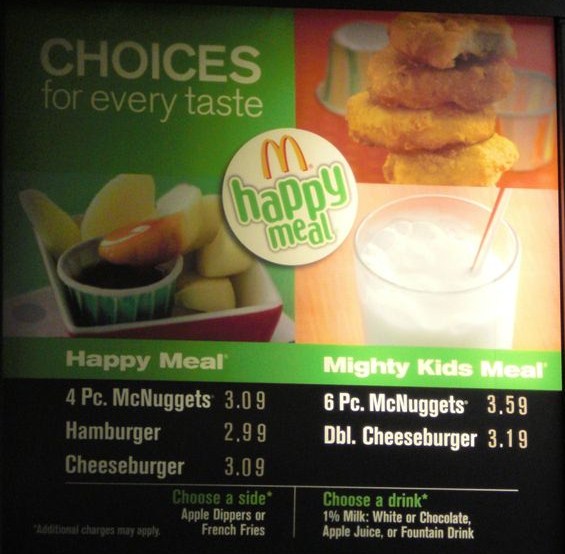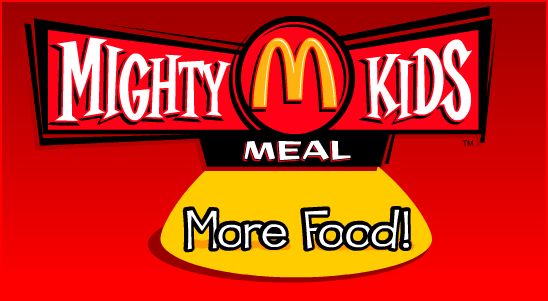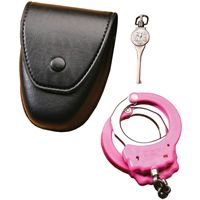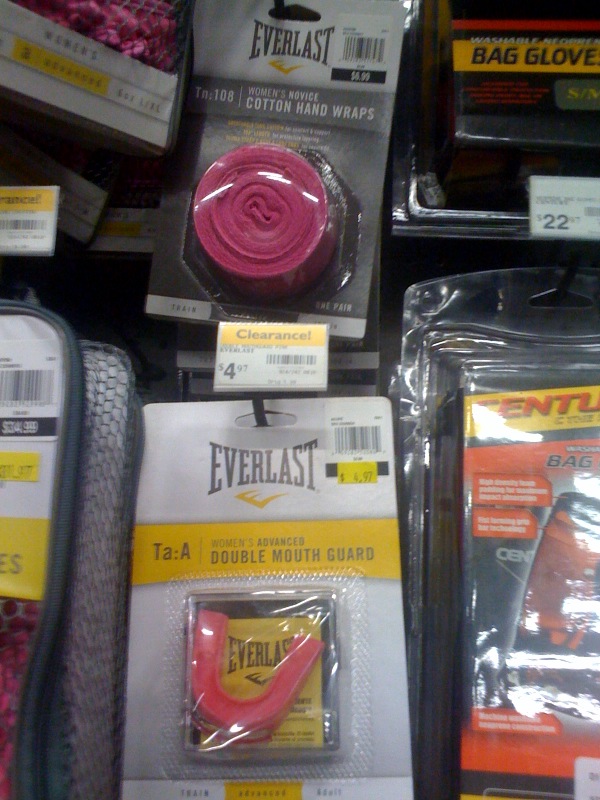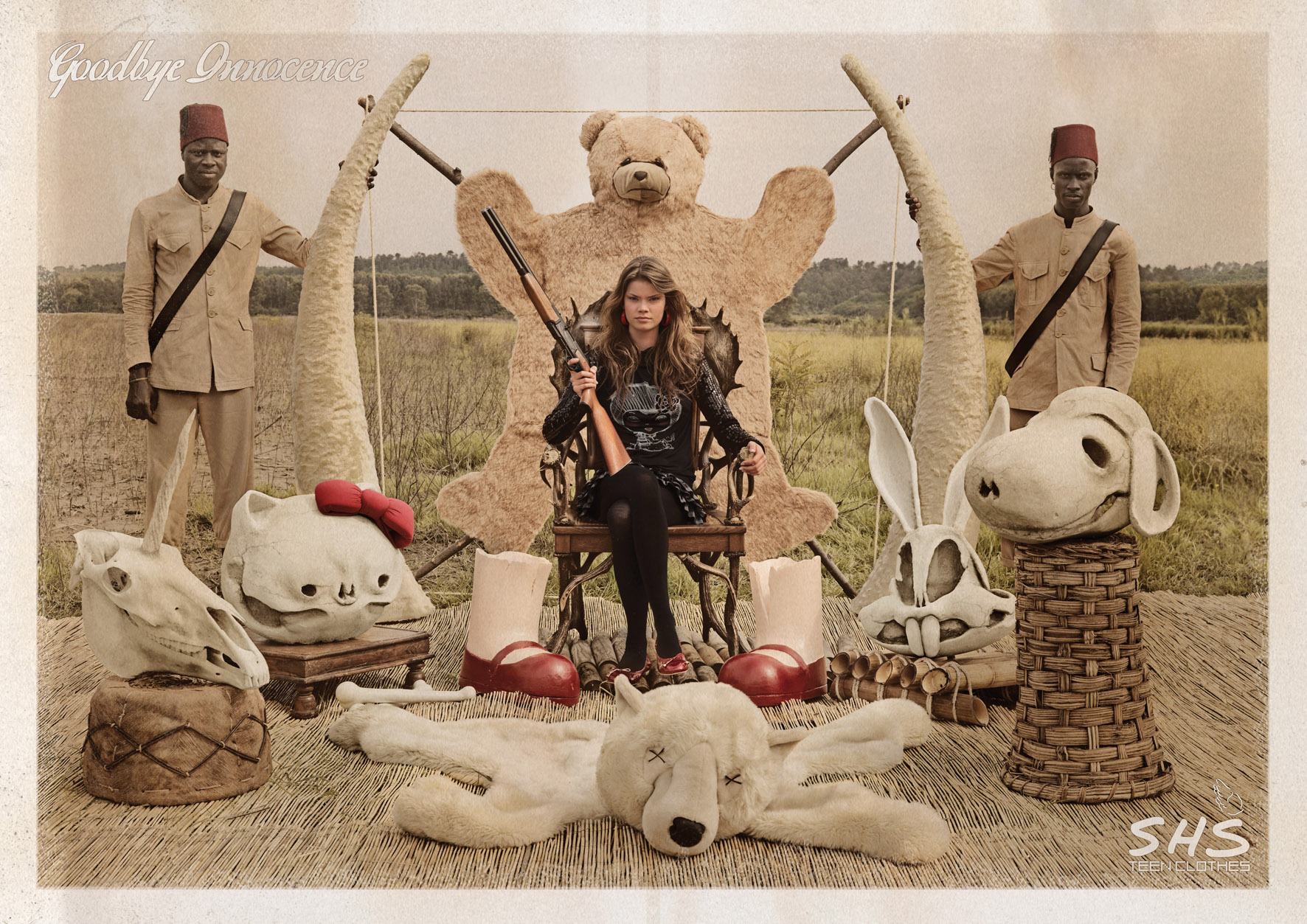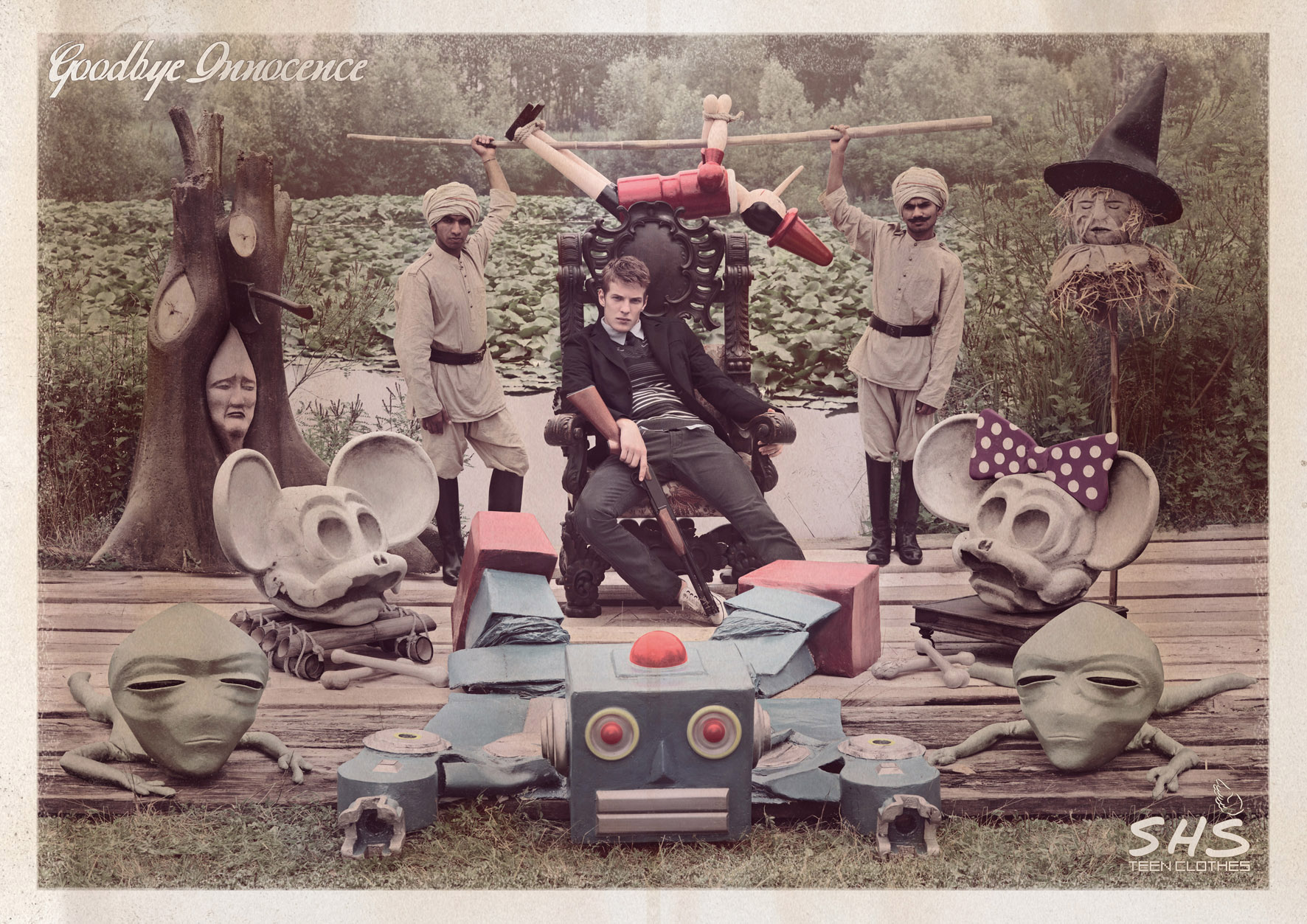Cristoph B. sent in this image (found here) of a woman who was supposedly paid by Kodak to “assvertise” at a trade show by wearing Kodak panties and… (well, it’s not safe for work):
media: marketing
Even in an era when children’s obesity is a significant problem (though a commenter points out that this is contested), the ever-upping of serving sizes at McDonald’s doesn’t appear to be skipping kids. Stephen W. took this picture at a McDonald’s in Pennsylvania this week.
Now McDonald’s doesn’t just offer Happy Meals, but Mighty Meals. Mighty Meals include a double cheeseburger instead of a hamburger or cheeseburger or a 6-piece McNugget instead of a 4-piece.
By the way, a Mighty Meal with a double cheeseburger has 780 calories.
And, really, what kid doesn’t want to be mighty? McDonald’s will sink pretty low for a few extra pennies.
Thanks for the tip and the picture, Stephen!
Muriel M.M. brought my attention to the catalog for Galls, a company that makes equipment and uniforms for public safety officers (military, police, firefighting, etc.). Muriel, an EMT, says,
The thing about their products is they don’t change much. Over the ten years I’ve received the catalog I can pretty much tell you what’s going to be in it: guns, batons, handcuffs, clothing such as boots, coats, uniforms, etc. Medical equipment and fire equipment are sold such as sirens, lights, latex gloves, breathing equipment. The list goes on and on.
But the newest version of the catalog Muriel received has something new: handcuffs now come in colors, not just silver. The options are blue, brown, gray, orange, yellow, and pink (light and bright!):
There are a couple of interesting things here. For one, it’s an attempt to provide a little (very limited) individualization to people who have to wear standard uniforms. Of course, it’s a superficial type of customization, similar to getting a cell phone of a particular color, but it provides at least some sense that the product reflects the personality or tastes of the user…something companies figured out long ago could boost sales (how many colors do cell phones come in these days?). Given that, I wonder how many police departments would allow officers to use brightly-colored handcuffs. Officers are allowed to buy customized items, but they can’t just go buy a different color of uniform; it may be that little personalized “touches” like this are allowed, though.
It’s also interesting to think about what the reaction might be to an officer who showed up at work with pink handcuffs. I wonder how many female officers would want to bring attention to their gender by using a product marked by the stereotypical feminine color. It also made me think of this post about cops in Thailand being punished by being forced to wear pink Hello Kitty armbands. I’m assuming a person would buy pink handcuffs to express their taste, but after looking at the old post, it made me wonder if anyone would ever put pink cuffs on male suspects just to try to annoy them. I bet one of my relatives who is a police officer would totally do that, except that it would require him to carry pink cuffs around all the time, which he would never, under any circumstances, do. He flipped out because his son liked a pink ball once.
NEW! Ben O. sent us a link to a similar product, Petals Workwear for Women. The company makes pink products for female construction workers.
Hard hat:

Tool belt:

Protective ear wear:
Protective eye wear:
NEW (Aug. ’10)! Garland Walton sent along these pink boxing accessories: gloves, tape, and a mouth guard. All in pink!
See also our post with a cartoon riffing on how people seem to think that pinkification is the answer to gender inequality.
via MultiCultClassics.
These ads, for a “fashion brand for teenagers” (according to Adverbox), use the trope of colonial taxidermic collection, to promise death to the tween love of Hello Kitty, Snoopie, Minnie and Mickey Mouse, teddy bears, unicorns, Bugs Bunny, Pinnochio, and more.
As a kid who hated Hello Kitty more than life itself and as an adult who just doesn’t get a life-long love of Disney, these ads appeal to me. As a sociologist, their colonial trappings disturb me. I’d love to hear your thoughts.
No longer just for the lovely, Unilever’s “Fair and Lovely” is being marketed to men (see here and here for ads for “Fair and Lovely”). The marketing is interesting on at least three levels:
(1) The ads exploits men’s insecurity about their appearance, just as they do for women.
(2) However, they masculinize the product with the “Fair and Handsome” name and, in the second commercial, by emphasizing the sporty-fighty-ness of the men using the product (see also our posts on make-up for men, masculinizing hair product, and selling hair dye to men).
(3) Though I don’t understand the language, the imagery of the arrows representing “Fair and Lovely” bouncing off of men’s skin seems to affirm the idea that men are inherently and biologically different from women… so much so that there would need to be a totally different product (kind of like the old “P.H. balanced for a woman” argument). Do correct me if I’m mistaken.
[youtube]http://www.youtube.com/watch?v=MgBevCTBTJw&feature=related[/youtube]
Via MultiCultClassics.
Lisa Wade, PhD is an Associate Professor at Tulane University. She is the author of American Hookup, a book about college sexual culture; a textbook about gender; and a forthcoming introductory text: Terrible Magnificent Sociology. You can follow her on Twitter and Instagram.

Andrew Sullivan suggests that this commercial for Pearl Cream that fetishizes (upper class) “Oriental” women is from the 1970s, but a commenter of his makes a good argument that it was on cable television in the ’80s and ’90s. Do you remember this commercial?
[youtube]http://www.youtube.com/watch?v=JaD_fvehAaU[/youtube]
Even in an era when children’s obesity is a significant problem (though a commenter points out that this is contested), the ever-upping of serving sizes at McDonald’s doesn’t appear to be skipping kids. Stephen W. took this picture at a McDonald’s in Pennsylvania this week.
Now McDonald’s doesn’t just offer Happy Meals, but Mighty Meals. Mighty Meals include a double cheeseburger instead of a hamburger or cheeseburger or a 6-piece McNugget instead of a 4-piece.
By the way, a Mighty Meal with a double cheeseburger has 780 calories.
And, really, what kid doesn’t want to be mighty? McDonald’s will sink pretty low for a few extra pennies.
Thanks for the tip and the picture, Stephen!
Muriel M.M. brought my attention to the catalog for Galls, a company that makes equipment and uniforms for public safety officers (military, police, firefighting, etc.). Muriel, an EMT, says,
The thing about their products is they don’t change much. Over the ten years I’ve received the catalog I can pretty much tell you what’s going to be in it: guns, batons, handcuffs, clothing such as boots, coats, uniforms, etc. Medical equipment and fire equipment are sold such as sirens, lights, latex gloves, breathing equipment. The list goes on and on.
But the newest version of the catalog Muriel received has something new: handcuffs now come in colors, not just silver. The options are blue, brown, gray, orange, yellow, and pink (light and bright!):
There are a couple of interesting things here. For one, it’s an attempt to provide a little (very limited) individualization to people who have to wear standard uniforms. Of course, it’s a superficial type of customization, similar to getting a cell phone of a particular color, but it provides at least some sense that the product reflects the personality or tastes of the user…something companies figured out long ago could boost sales (how many colors do cell phones come in these days?). Given that, I wonder how many police departments would allow officers to use brightly-colored handcuffs. Officers are allowed to buy customized items, but they can’t just go buy a different color of uniform; it may be that little personalized “touches” like this are allowed, though.
It’s also interesting to think about what the reaction might be to an officer who showed up at work with pink handcuffs. I wonder how many female officers would want to bring attention to their gender by using a product marked by the stereotypical feminine color. It also made me think of this post about cops in Thailand being punished by being forced to wear pink Hello Kitty armbands. I’m assuming a person would buy pink handcuffs to express their taste, but after looking at the old post, it made me wonder if anyone would ever put pink cuffs on male suspects just to try to annoy them. I bet one of my relatives who is a police officer would totally do that, except that it would require him to carry pink cuffs around all the time, which he would never, under any circumstances, do. He flipped out because his son liked a pink ball once.
NEW! Ben O. sent us a link to a similar product, Petals Workwear for Women. The company makes pink products for female construction workers.
Hard hat:

Tool belt:

Protective ear wear:
Protective eye wear:
NEW (Aug. ’10)! Garland Walton sent along these pink boxing accessories: gloves, tape, and a mouth guard. All in pink!
See also our post with a cartoon riffing on how people seem to think that pinkification is the answer to gender inequality.
via MultiCultClassics.
These ads, for a “fashion brand for teenagers” (according to Adverbox), use the trope of colonial taxidermic collection, to promise death to the tween love of Hello Kitty, Snoopie, Minnie and Mickey Mouse, teddy bears, unicorns, Bugs Bunny, Pinnochio, and more.
As a kid who hated Hello Kitty more than life itself and as an adult who just doesn’t get a life-long love of Disney, these ads appeal to me. As a sociologist, their colonial trappings disturb me. I’d love to hear your thoughts.
No longer just for the lovely, Unilever’s “Fair and Lovely” is being marketed to men (see here and here for ads for “Fair and Lovely”). The marketing is interesting on at least three levels:
(1) The ads exploits men’s insecurity about their appearance, just as they do for women.
(2) However, they masculinize the product with the “Fair and Handsome” name and, in the second commercial, by emphasizing the sporty-fighty-ness of the men using the product (see also our posts on make-up for men, masculinizing hair product, and selling hair dye to men).
(3) Though I don’t understand the language, the imagery of the arrows representing “Fair and Lovely” bouncing off of men’s skin seems to affirm the idea that men are inherently and biologically different from women… so much so that there would need to be a totally different product (kind of like the old “P.H. balanced for a woman” argument). Do correct me if I’m mistaken.
[youtube]http://www.youtube.com/watch?v=MgBevCTBTJw&feature=related[/youtube]
Via MultiCultClassics.
Lisa Wade, PhD is an Associate Professor at Tulane University. She is the author of American Hookup, a book about college sexual culture; a textbook about gender; and a forthcoming introductory text: Terrible Magnificent Sociology. You can follow her on Twitter and Instagram.

Andrew Sullivan suggests that this commercial for Pearl Cream that fetishizes (upper class) “Oriental” women is from the 1970s, but a commenter of his makes a good argument that it was on cable television in the ’80s and ’90s. Do you remember this commercial?
[youtube]http://www.youtube.com/watch?v=JaD_fvehAaU[/youtube]

